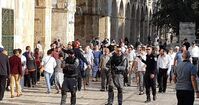22 apr 2019
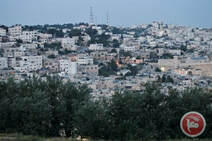
An Israeli court ordered the eviction of Israeli settlers from a Palestinian-owned home that they held illegally since 2005 in Hebron City, in the southern occupied West Bank district of Hebron, on Monday.
Hebrew-language news outlets reported that the Jerusalem Magistrate Court rejected claims by Israeli settlers, stating that given their "long occupation" of the property and their investments to improve it, the home should remain theirs.
The court rejected the claims and ordered the Israeli settlers to pay the Palestinian family 580,000 shekels ($161,000) as compensation for the years it was held illegally by the settlers.
The legal owners, the Bakri family, were represented by attorney, Samer Shehadeh, who confirmed that the Israeli settlers were appealing the court ruling.
The home is located in the Tel Rumeida neighborhood, in the center of Hebron City, and sits on 0.75 acres of land.
Palestinian residents in Hebron said that Tal Construction & Investments LTD., the company which bought the home based on forged documents, is registered as a Jordanian company, however, is operated by Israeli settlers who aim to promote illegal settlements across the occupied West Bank.
Tal Construction bought the Hebron home in 2005 from Hani al-Batash, who claimed to have legal rights over the property, for $300,000 and handed it over to Israeli families.
Nevertheless, Israeli police launched an investigation into the issue and determined that the documents used during the transaction were forged and that al-Batash was not the legal owner of the property.
The area of Tel Rumeida has long been a flash-point for tensions between Palestinians and Israeli settlers and military, as it is located near illegal Israeli settlements whose residents are notoriously aggressive toward Palestinians.
Tel Rumeida is located within the area of the city designated as H2, an area taking over the bulk of Hebron's Old City that is under full Israeli military control, and the site of five illegal Israeli settlements which continually expand into surrounding Palestinian neighborhoods.
The Israeli-controlled H2 area is home to 30,000 Palestinians and around 800 Israeli settlers who live under the protection of Israeli forces.
Some 800 notoriously aggressive Israeli settlers now live under the protection of the Israeli military in the Old City of Hebron, surrounded by more than 30,000 Palestinians.
Hebrew-language news outlets reported that the Jerusalem Magistrate Court rejected claims by Israeli settlers, stating that given their "long occupation" of the property and their investments to improve it, the home should remain theirs.
The court rejected the claims and ordered the Israeli settlers to pay the Palestinian family 580,000 shekels ($161,000) as compensation for the years it was held illegally by the settlers.
The legal owners, the Bakri family, were represented by attorney, Samer Shehadeh, who confirmed that the Israeli settlers were appealing the court ruling.
The home is located in the Tel Rumeida neighborhood, in the center of Hebron City, and sits on 0.75 acres of land.
Palestinian residents in Hebron said that Tal Construction & Investments LTD., the company which bought the home based on forged documents, is registered as a Jordanian company, however, is operated by Israeli settlers who aim to promote illegal settlements across the occupied West Bank.
Tal Construction bought the Hebron home in 2005 from Hani al-Batash, who claimed to have legal rights over the property, for $300,000 and handed it over to Israeli families.
Nevertheless, Israeli police launched an investigation into the issue and determined that the documents used during the transaction were forged and that al-Batash was not the legal owner of the property.
The area of Tel Rumeida has long been a flash-point for tensions between Palestinians and Israeli settlers and military, as it is located near illegal Israeli settlements whose residents are notoriously aggressive toward Palestinians.
Tel Rumeida is located within the area of the city designated as H2, an area taking over the bulk of Hebron's Old City that is under full Israeli military control, and the site of five illegal Israeli settlements which continually expand into surrounding Palestinian neighborhoods.
The Israeli-controlled H2 area is home to 30,000 Palestinians and around 800 Israeli settlers who live under the protection of Israeli forces.
Some 800 notoriously aggressive Israeli settlers now live under the protection of the Israeli military in the Old City of Hebron, surrounded by more than 30,000 Palestinians.
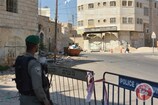
Israeli forces sealed off the Ibrahimi Mosque in front of Muslim worshipers, on Monday, in preparation for Israeli settlers raid for the third day of the Jewish holiday of Passover.
Israeli forces were heavily deployed around the holy site.
The mosque, believed to be the burial place of the prophet Abraham, is sacred to both Muslims and Jews and has been the site of oft-violent tensions for decades.
The holy site was split into a synagogue -- known to Jews as the Cave of Patriarchs -- and a mosque after US-born Israeli settler Baruch Goldstein massacred 29 Palestinians inside the mosque in 1994.
Since the split, Muslim worshipers have been denied access to the site during Jewish holidays and vice versa in effort to prevent violence from erupting at the holy site.
Located in the center of Hebron -- one of the largest cities in the occupied West Bank -- the Old City was also divided into Palestinian and Israeli-controlled areas at the time, known as H1 and H2.
Some 800 notoriously aggressive settlers now live under the protection of the Israeli military in the Old City, surrounded by more than 30,000 Palestinians.
Israeli forces were heavily deployed around the holy site.
The mosque, believed to be the burial place of the prophet Abraham, is sacred to both Muslims and Jews and has been the site of oft-violent tensions for decades.
The holy site was split into a synagogue -- known to Jews as the Cave of Patriarchs -- and a mosque after US-born Israeli settler Baruch Goldstein massacred 29 Palestinians inside the mosque in 1994.
Since the split, Muslim worshipers have been denied access to the site during Jewish holidays and vice versa in effort to prevent violence from erupting at the holy site.
Located in the center of Hebron -- one of the largest cities in the occupied West Bank -- the Old City was also divided into Palestinian and Israeli-controlled areas at the time, known as H1 and H2.
Some 800 notoriously aggressive settlers now live under the protection of the Israeli military in the Old City, surrounded by more than 30,000 Palestinians.
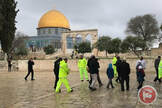
The Israeli Minister of Agriculture, Uri Ariel, raided the Al-Aqsa Mosque compound in occupied East Jerusalem on Monday, the third day of the Jewish holiday of Passover, along with dozens of Israeli settlers.
Head of the public relations office at the Islamic Endowment Department, Firas al-Dibs, said that Ariel, along with at least 170 Israeli settlers, raided the Al-Aqsa compound via the Moroccans Gate under armed security by Israeli forces.
Witnesses reported that several Israeli settlers performed prayers and religious rituals during the raid. video
The Al-Aqsa Mosque compound, which sits just above the Western Wall plaza, houses both the Dome of the Rock and Al-Aqsa mosque. The third holiest site in Islam, it is also venerated as Judaism's most holy place, as it sits where Jews believe the First and Second Temples once stood.
While Jewish visitation is permitted to the compound, non-Muslim worship at Al-Aqsa is prohibited according to an agreement signed between Israel and the Jordanian government after Israel's illegal occupation of East Jerusalem in 1967.
Despite the agreement with Jordan -- which is the custodian of Al-Aqsa -- Israeli authorities regularly allow Jewish visitors to enter the site, often under armed guard. Such visits are typically made by right-wingers attempting to unsettle the status quo at the site, and coincide with restrictions on Palestinian access, including bans on entrance and detentions.
Head of the public relations office at the Islamic Endowment Department, Firas al-Dibs, said that Ariel, along with at least 170 Israeli settlers, raided the Al-Aqsa compound via the Moroccans Gate under armed security by Israeli forces.
Witnesses reported that several Israeli settlers performed prayers and religious rituals during the raid. video
The Al-Aqsa Mosque compound, which sits just above the Western Wall plaza, houses both the Dome of the Rock and Al-Aqsa mosque. The third holiest site in Islam, it is also venerated as Judaism's most holy place, as it sits where Jews believe the First and Second Temples once stood.
While Jewish visitation is permitted to the compound, non-Muslim worship at Al-Aqsa is prohibited according to an agreement signed between Israel and the Jordanian government after Israel's illegal occupation of East Jerusalem in 1967.
Despite the agreement with Jordan -- which is the custodian of Al-Aqsa -- Israeli authorities regularly allow Jewish visitors to enter the site, often under armed guard. Such visits are typically made by right-wingers attempting to unsettle the status quo at the site, and coincide with restrictions on Palestinian access, including bans on entrance and detentions.
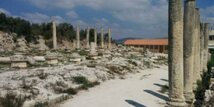
Israeli forces sealed off the three entrances to the village of Sebastia, north of Nablus, occupied West Bank, as they prepared to celebrate the Jewish holiday of Passover, also known as “Pesach”, according to the mayor of Sebastia, Mohammed Azim.
Israeli forces stormed the village of Sebastia at dawn and placed large cement cubes to completely block off the three entrances to the village, to secure the entry of settlers into Sebastia archaeological site, in celebration of Passover.
Forces reportedly marked the houses and alleys where they intended to deploy troops.
The mayor noted that the village is subjected to almost daily violations by Israeli forces, including raids, harassment and arrests, in an attempt to take over the archaeological site.
Israeli forces stormed the village of Sebastia at dawn and placed large cement cubes to completely block off the three entrances to the village, to secure the entry of settlers into Sebastia archaeological site, in celebration of Passover.
Forces reportedly marked the houses and alleys where they intended to deploy troops.
The mayor noted that the village is subjected to almost daily violations by Israeli forces, including raids, harassment and arrests, in an attempt to take over the archaeological site.
21 apr 2019
Extremist Jewish groups recently incited their followers and supporters to march en masse to the Old City and the Aqsa Mosque during the passover days, from Sunday until next Thursday.
Last Thursday, Jewish settlers attempted to perform ritual animal sacrifices inside the Aqsa Mosque compound in response to calls made by temple mount groups to make such rituals at the Islamic holy sites, but the Israeli police claimed they arrested them to prevent angry reactions by Muslims.
According to the Hebrew media, the police promised temple groups to secure their mass break-ins at the Aqsa Mosque during the passover days.
Last Thursday, Jewish settlers attempted to perform ritual animal sacrifices inside the Aqsa Mosque compound in response to calls made by temple mount groups to make such rituals at the Islamic holy sites, but the Israeli police claimed they arrested them to prevent angry reactions by Muslims.
According to the Hebrew media, the police promised temple groups to secure their mass break-ins at the Aqsa Mosque during the passover days.
20 apr 2019
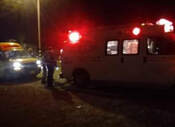
A speeding illegal Israeli colonist rammed with his car, on Saturday evening, a Palestinian child in the al-Ferdees Mountain area, east of Bethlehem, in the occupied West Bank.
Media sources said the child, only five years of age, suffered various cuts and bruises, and that his wounds were described as moderate-but-stable.
They added that an Israeli ambulance was called to the scene and provided the needed medical attention to the wounded child, but did not move him to an Israeli hospital.
A Palestinian Red Crescent ambulance was then called to the scene and rushed the child to a hospital in Bethlehem.
Israeli settler runs over 5-year-old boy in Bethlehem
An Israeli settler on Saturday evening deliberately hit a Palestinian child with his car in Freidis village, east of Bethlehem.
Local sources said that Mohammed Askar, 5, was transferred to a hospital in Jerusalem after he suffered moderate injuries in the attack.
Israeli settlers' deliberate hit-and-run attacks targeting Palestinian citizens, especially children, have stepped up recently in the occupied West Bank.
There are 427 illegal settler outposts in the West Bank. They cover about 46% of its area, and are inhabited by over 700,000 Israelis who carry out daily attacks on the Palestinians.
Media sources said the child, only five years of age, suffered various cuts and bruises, and that his wounds were described as moderate-but-stable.
They added that an Israeli ambulance was called to the scene and provided the needed medical attention to the wounded child, but did not move him to an Israeli hospital.
A Palestinian Red Crescent ambulance was then called to the scene and rushed the child to a hospital in Bethlehem.
Israeli settler runs over 5-year-old boy in Bethlehem
An Israeli settler on Saturday evening deliberately hit a Palestinian child with his car in Freidis village, east of Bethlehem.
Local sources said that Mohammed Askar, 5, was transferred to a hospital in Jerusalem after he suffered moderate injuries in the attack.
Israeli settlers' deliberate hit-and-run attacks targeting Palestinian citizens, especially children, have stepped up recently in the occupied West Bank.
There are 427 illegal settler outposts in the West Bank. They cover about 46% of its area, and are inhabited by over 700,000 Israelis who carry out daily attacks on the Palestinians.
19 apr 2019
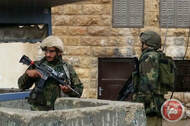
Israeli settlers attacked a Palestinian family on al-Shuhada Street, in Hebron City, in the southern occupied West Bank, on late Thursday.
Local sources told Ma'an that Israeli settlers stormed the al-Shuhada Street in the center of Hebron City and broke into a Palestinian home, identified as belonging to Ishaq Ramadan.
Ishaq Ramadan said that after the Israeli settlers broke into his home and attacked him along with his family with pepper-spray.
Ishaq Ramadan added that the attack caused him a severe skin irritation and difficulty breathing.
Israeli settlers reportedly physically attacked other Palestinian residents present on al-Shuhada Street.
Palestinian residents of the Old City of Hebron face a large Israeli military presence on a daily basis, with at least 32 permanent and partial checkpoints set up at the entrances of many streets.
Additionally, Palestinians are not allowed to drive on al-Shuhada street, have had their homes and shops on the street welded shut and in some areas of the Old City, they are not permitted to walk on certain roads.
Meanwhile, Israeli settlers move freely on the street, drive cars and carry machine guns.
Local sources told Ma'an that Israeli settlers stormed the al-Shuhada Street in the center of Hebron City and broke into a Palestinian home, identified as belonging to Ishaq Ramadan.
Ishaq Ramadan said that after the Israeli settlers broke into his home and attacked him along with his family with pepper-spray.
Ishaq Ramadan added that the attack caused him a severe skin irritation and difficulty breathing.
Israeli settlers reportedly physically attacked other Palestinian residents present on al-Shuhada Street.
Palestinian residents of the Old City of Hebron face a large Israeli military presence on a daily basis, with at least 32 permanent and partial checkpoints set up at the entrances of many streets.
Additionally, Palestinians are not allowed to drive on al-Shuhada street, have had their homes and shops on the street welded shut and in some areas of the Old City, they are not permitted to walk on certain roads.
Meanwhile, Israeli settlers move freely on the street, drive cars and carry machine guns.
18 apr 2019
|
|
On the morning of 17 March 2019, a Palestinian stabbed and shot dead an Israeli soldier, Gal Keidan, and later shot a settler, Achiad Ettinger, (after stealing his car at Ariel junction). He also fired at other soldiers. Ettinger died of his wounds the next day. One of the soldiers was seriously wounded.
Immediately after the incident, settlers set out to attack Palestinians throughout the West Bank. During this five-day rampage, settlers attacked individuals traveling in cars; and raided villages, accompanied by soldiers who not only failed to stop the settlers, but joined in on the attack, firing rubber-coated metal bullets and live rounds at Palestinians. Settlers also staged nocturnal raids into Palestinian villages, vandalizing cars and defacing a mosque. |
Attacks of this sort happen after nearly every attack by a Palestinian, so it stands to reason that Israeli security forces should have taken measures to prevent these attacks and protect Palestinians from the assailants. But, as it has done in the past, the security establishment did nothing, once again giving settlers a free hand to attack Palestinians, and sometimes even helping them. These are neither aberrations nor “bad apples.” Rather, it is conduct that is commensurate with Israel’s longstanding policy in the West Bank, serving it and helping it achieve its goals.
Descriptions of several incidents and testimonies from some of the victims follow:
Al-‘Einab Road, near Deir Ibzi’, Ramallah District, 17 March 2019On 17 March 2019, at around 10:00 P.M., about ten settlers attacked Wasfi Zeita’s car, on al-‘Einab Road, near the entrance to the village of Deir Ibzi’. Zeita, 31, a married father of three, lives in the village of ‘Ein ‘Arik and was on his way home. The settlers scattered rocks along the road, trying to block the car, beat Zeita with metal rods through the car windows, and tried to gain control of the car. Zeita drove faster and managed to escape.
Descriptions of several incidents and testimonies from some of the victims follow:
Al-‘Einab Road, near Deir Ibzi’, Ramallah District, 17 March 2019On 17 March 2019, at around 10:00 P.M., about ten settlers attacked Wasfi Zeita’s car, on al-‘Einab Road, near the entrance to the village of Deir Ibzi’. Zeita, 31, a married father of three, lives in the village of ‘Ein ‘Arik and was on his way home. The settlers scattered rocks along the road, trying to block the car, beat Zeita with metal rods through the car windows, and tried to gain control of the car. Zeita drove faster and managed to escape.
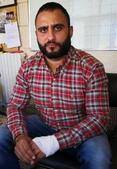
Al-‘Einab Road, near Deir Ibzi’, Ramallah District, 17 March 2019
On 17 March 2019, at around 10:00 P.M., about ten settlers attacked Wasfi Zeita’s car, on al-‘Einab Road, near the entrance to the village of Deir Ibzi’. Zeita, 31, a married father of three, lives in the village of ‘Ein ‘Arik and was on his way home. The settlers scattered rocks along the road, trying to block the car, beat Zeita with metal rods through the car windows, and tried to gain control of the car. Zeita drove faster and managed to escape.
This is what he related in a testimony he gave B’Tselem field researcher Iyad Hadad on 19 March 2019:
At around 10:00 P.M., I was visiting the village of Kharbatha Bani Harith. I saw on social media that the military was blocking the entrances to a few villages because of the attack that happened near Ariel. I decided not to linger and go home. When I was about 30 meters away from the gate at the entrance to the village of Deir Ibzi’ (the road to ‘Ein ‘Arik goes through the village), I saw rocks of different sizes scattered along the road.
They interfered with the driving. I thought the military had put the rocks there and closed the road. I thought I’d take the chance and drive past them so I wouldn’t have to go all the way back and take a different route home. I only had a few meters left to get through the segment the military sometimes closes. There was a truck behind me. When we turned into the al-‘Einab Road (which goes from Route 463 to Deir Ibzi’), it was dark because there is no lighting there.
I drove another 30 meters, but the gate on the way was closed, and there were no soldiers or anyone else. I rolled down the window to try to see the road better, and then I saw the headlights of five or six cars that were parked near Dolev Junction. I guessed those were settlers’ cars, and I got scared. I turned to go back, and then saw 10-12 settlers approaching from the right, from the direction of the parked cars. They were about 30 meters away from me.
When they saw me and the truck that was driving behind me, they split into two groups. Three settlers dragged some barbed wire fencing that was near the road and used it to block the road ahead of me. The others came toward me. Two of them were wearing masks and two were holding wooden sticks or metal rods. The others were holding stones. They looked like they were ready to attack.
I rolled down the window beside me, so the rocks wouldn’t shatter it. The settlers started throwing stones and they hit the body of the car. Three of them came right up to me and put their hands inside the car. Two tried to open the door and hit me on the arms with the poles. They felt like metal rods. The third one tried to turn the steering wheel and get me off the road. I pushed them through the window a few times. It was all like a scene from a Hollywood action movie, especially since I was still driving between the rocks that were scattered on the road. I was very careful not to run over the settlers who were blocking my path, and I was also pushing the settlers who were trying to take over my car.
I was scared they were going to kill me. I drove faster and managed to get past the barbed wire. I drove over it, but it stuck to the underside of the car and got dragged for about 30 meters. Lucky it didn’t puncture the tires.
I managed to get away and go back on the same road I’d come on. I went back to Kharbatha Bani Harith, and from there I went through Bil’in, Kafr Ni’ma and Deir Ibzi’. I got to my village, ‘Ein ‘Arik, only at 11:00 o’clock. I had bruises and a wound on my arm. When I got home, I checked the car and found a stone inside. The windshield had cracked but had not broken because it has protective coating. The hood was also damaged, and there were two dents on the body of the car. The bumper was destroyed.
I don’t know what happened to the truck that was driving behind me. It’s by the grace of God that I got out of this alive, maybe also because the settlers were busy attacking the truck.
On 17 March 2019, at around 10:00 P.M., about ten settlers attacked Wasfi Zeita’s car, on al-‘Einab Road, near the entrance to the village of Deir Ibzi’. Zeita, 31, a married father of three, lives in the village of ‘Ein ‘Arik and was on his way home. The settlers scattered rocks along the road, trying to block the car, beat Zeita with metal rods through the car windows, and tried to gain control of the car. Zeita drove faster and managed to escape.
This is what he related in a testimony he gave B’Tselem field researcher Iyad Hadad on 19 March 2019:
At around 10:00 P.M., I was visiting the village of Kharbatha Bani Harith. I saw on social media that the military was blocking the entrances to a few villages because of the attack that happened near Ariel. I decided not to linger and go home. When I was about 30 meters away from the gate at the entrance to the village of Deir Ibzi’ (the road to ‘Ein ‘Arik goes through the village), I saw rocks of different sizes scattered along the road.
They interfered with the driving. I thought the military had put the rocks there and closed the road. I thought I’d take the chance and drive past them so I wouldn’t have to go all the way back and take a different route home. I only had a few meters left to get through the segment the military sometimes closes. There was a truck behind me. When we turned into the al-‘Einab Road (which goes from Route 463 to Deir Ibzi’), it was dark because there is no lighting there.
I drove another 30 meters, but the gate on the way was closed, and there were no soldiers or anyone else. I rolled down the window to try to see the road better, and then I saw the headlights of five or six cars that were parked near Dolev Junction. I guessed those were settlers’ cars, and I got scared. I turned to go back, and then saw 10-12 settlers approaching from the right, from the direction of the parked cars. They were about 30 meters away from me.
When they saw me and the truck that was driving behind me, they split into two groups. Three settlers dragged some barbed wire fencing that was near the road and used it to block the road ahead of me. The others came toward me. Two of them were wearing masks and two were holding wooden sticks or metal rods. The others were holding stones. They looked like they were ready to attack.
I rolled down the window beside me, so the rocks wouldn’t shatter it. The settlers started throwing stones and they hit the body of the car. Three of them came right up to me and put their hands inside the car. Two tried to open the door and hit me on the arms with the poles. They felt like metal rods. The third one tried to turn the steering wheel and get me off the road. I pushed them through the window a few times. It was all like a scene from a Hollywood action movie, especially since I was still driving between the rocks that were scattered on the road. I was very careful not to run over the settlers who were blocking my path, and I was also pushing the settlers who were trying to take over my car.
I was scared they were going to kill me. I drove faster and managed to get past the barbed wire. I drove over it, but it stuck to the underside of the car and got dragged for about 30 meters. Lucky it didn’t puncture the tires.
I managed to get away and go back on the same road I’d come on. I went back to Kharbatha Bani Harith, and from there I went through Bil’in, Kafr Ni’ma and Deir Ibzi’. I got to my village, ‘Ein ‘Arik, only at 11:00 o’clock. I had bruises and a wound on my arm. When I got home, I checked the car and found a stone inside. The windshield had cracked but had not broken because it has protective coating. The hood was also damaged, and there were two dents on the body of the car. The bumper was destroyed.
I don’t know what happened to the truck that was driving behind me. It’s by the grace of God that I got out of this alive, maybe also because the settlers were busy attacking the truck.
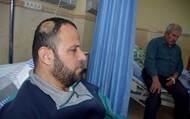
Nablus - Tulkarm road, 4 kilometers from Deir Sharaf, Nablus District, 17 March 2019
On 17 March 2019, at around 8:30 P.M., at least ten settlers attacked a Palestinian Electric Company van that was parked by the side of the Tulkarm-Nablus, about four kilometers away from the village of Deir Sharaf. Three employees of the Electric Company were inside the van, Raed a-Thilth, Nashaat Dweikat and Samer al-Hayat.
They were waiting for a resident of Deir Sharaf to accompany them to a neighborhood where there was a problem with the electricity. Stones hit Raed a-Thilth and Nashaat Dweikat in the head. A-Thilth also suffered eye injuries because glass splinters went into his eyes. Both men were taken to the Arab Hospital in Nablus for treatment.
On 17 March 2019, at around 8:30 P.M., at least ten settlers attacked a Palestinian Electric Company van that was parked by the side of the Tulkarm-Nablus, about four kilometers away from the village of Deir Sharaf. Three employees of the Electric Company were inside the van, Raed a-Thilth, Nashaat Dweikat and Samer al-Hayat.
They were waiting for a resident of Deir Sharaf to accompany them to a neighborhood where there was a problem with the electricity. Stones hit Raed a-Thilth and Nashaat Dweikat in the head. A-Thilth also suffered eye injuries because glass splinters went into his eyes. Both men were taken to the Arab Hospital in Nablus for treatment.
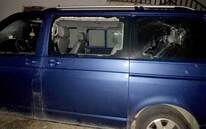
In a testimony he gave B’Tselem field researcher Salma a-Dib’i on 18 March 2019, Raed a-Thilth, 45, a married father of five, from Beit Iba, Nablus District, spoke about the attack:
I work as a driver for the Palestine Electric Company. That day, we’d arrived near the City Club Community Center, about ten kilometers away from Nablus, and were waiting for a man who had reported an electrical problem. Suddenly, the vehicle got hit by many stones from all directions.
At first, I thought it was gunshots, because the noise was very frightening. I felt a sharp pain on the left side of my head and blood started running down my face. I felt my head, and didn’t know what to do, because Samer and Nashaat, who were in the van, were asking me to drive away from there at the same time. I was so stressed I couldn’t start the engine. Then I realized it was already running. I drove without looking right or left, just straight ahead. I don’t even know how I managed to drive. The windshield was shattered and the wind blew glass splinters into my eyes. I drove until the roundabout near Deir Sharaf.
Nashaat called the company office, reported the incident and asked them to call for an ambulance. People from the village came to the roundabout. They brought us water and cotton balls and tried to care for us until a Red Crescent ambulance came and took us to the Arab Hospital.
Jinsafut, Qalqiliyah District, 17 March 2019
On 17 March 2019, at around 7:00 P.M., about 15 settlers attacked the Bashir family home in the village of Jinsafut, Qalqiliyah District. The settlers broke two windows in the Bashir home. They also, smashed windows and slashed the tires of two of commercial vehicles and one private car that were parked on the street and belong to neighbors.
In a testimony he gave B’Tselem field researcher Abdulkarim Sadi on 18 March 2019, Issam Bashir, 28, spoke about the attack:
I work as a driver for the Palestine Electric Company. That day, we’d arrived near the City Club Community Center, about ten kilometers away from Nablus, and were waiting for a man who had reported an electrical problem. Suddenly, the vehicle got hit by many stones from all directions.
At first, I thought it was gunshots, because the noise was very frightening. I felt a sharp pain on the left side of my head and blood started running down my face. I felt my head, and didn’t know what to do, because Samer and Nashaat, who were in the van, were asking me to drive away from there at the same time. I was so stressed I couldn’t start the engine. Then I realized it was already running. I drove without looking right or left, just straight ahead. I don’t even know how I managed to drive. The windshield was shattered and the wind blew glass splinters into my eyes. I drove until the roundabout near Deir Sharaf.
Nashaat called the company office, reported the incident and asked them to call for an ambulance. People from the village came to the roundabout. They brought us water and cotton balls and tried to care for us until a Red Crescent ambulance came and took us to the Arab Hospital.
Jinsafut, Qalqiliyah District, 17 March 2019
On 17 March 2019, at around 7:00 P.M., about 15 settlers attacked the Bashir family home in the village of Jinsafut, Qalqiliyah District. The settlers broke two windows in the Bashir home. They also, smashed windows and slashed the tires of two of commercial vehicles and one private car that were parked on the street and belong to neighbors.
In a testimony he gave B’Tselem field researcher Abdulkarim Sadi on 18 March 2019, Issam Bashir, 28, spoke about the attack:
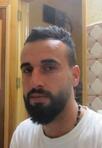
Yesterday, at about 7:00 P.M., I was home with my family. A friend texted me that there was a group of people on the road near our house. I went to the window overlooking the road and saw about ten settlers smashing the windows of my relative’s car from all directions. The settlers started throwing stones at my house. The windows in the guest room and in another room on the second floor shattered.
I climbed to the rooftop, above the third floor, and caught sight of the settlers running away. There were about 15 of them. They got into three cars that were waiting for them at the eastern entrance to our village, about 150 meters away from our house. They drove toward the road leading to Immanuel. When I climbed down from the roof, I saw they had also smashed the windows of two commercial vehicles and punctured their tires.
The settlers had no reason to attack us and damage our property. Our village is quiet and there haven’t been any problems with the military or the settlers.
On Monday night, at around 1:00 A.M., a military force came to our house. The soldiers questioned us about the attack and the damage the settlers had done to the cars and houses. They asked if there were security cameras in our neighborhood, but there are none. They left after ten minutes.
Entrance to the compound that is the former location of the settlement of Homesh, Jenin District, 18 March 2019:
On 18 March 2019, at around 11:00 P.M., Rawan Ighbariyah , 23, and her brother Nizar, 30, from the village of Kufeirit, Jenin District, were driving to Rawda College in Nablus. The two pulled over to take a break at the entrance to the compound that had previously been the site of the settlement of Homesh. The settlement, near the village of Silat a-Dhahr, had been evacuated in 2005. Nizar went into the compound.
When he was fifty meters away from the car, he was attacked from behind by a masked settler, who then threw stones at him, as did another masked settler. At the same time, about five other settlers threw stones at the car, with Rawan still inside it. One stone hit her in the stomach. She ran out of the car, and was hit by stones in the left leg and back.
In a testimony he gave B’Tselem field researcher Abdulkarim Sadi the next day, Nizar Ighbariyah described how the incident began:
I climbed to the rooftop, above the third floor, and caught sight of the settlers running away. There were about 15 of them. They got into three cars that were waiting for them at the eastern entrance to our village, about 150 meters away from our house. They drove toward the road leading to Immanuel. When I climbed down from the roof, I saw they had also smashed the windows of two commercial vehicles and punctured their tires.
The settlers had no reason to attack us and damage our property. Our village is quiet and there haven’t been any problems with the military or the settlers.
On Monday night, at around 1:00 A.M., a military force came to our house. The soldiers questioned us about the attack and the damage the settlers had done to the cars and houses. They asked if there were security cameras in our neighborhood, but there are none. They left after ten minutes.
Entrance to the compound that is the former location of the settlement of Homesh, Jenin District, 18 March 2019:
On 18 March 2019, at around 11:00 P.M., Rawan Ighbariyah , 23, and her brother Nizar, 30, from the village of Kufeirit, Jenin District, were driving to Rawda College in Nablus. The two pulled over to take a break at the entrance to the compound that had previously been the site of the settlement of Homesh. The settlement, near the village of Silat a-Dhahr, had been evacuated in 2005. Nizar went into the compound.
When he was fifty meters away from the car, he was attacked from behind by a masked settler, who then threw stones at him, as did another masked settler. At the same time, about five other settlers threw stones at the car, with Rawan still inside it. One stone hit her in the stomach. She ran out of the car, and was hit by stones in the left leg and back.
In a testimony he gave B’Tselem field researcher Abdulkarim Sadi the next day, Nizar Ighbariyah described how the incident began:
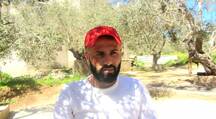
I pulled the jeep over to go take a leak. I had gone about 50 meters, when suddenly I heard someone yelling and got hit in the back with a stick. I turned around and saw two masked men in civilian clothing. They were shouting in Hebrew, and had sidelocks, so I figured they were settlers.
I heard my sister Rawan screaming, and realized other settlers were attacking her. I quickly ran over to her and saw 7 or 8 settlers who looked like those who had attacked me. They were standing about 10 meters away from the jeep, pelting it with stones. I saw Rawan get out of the jeep and run away. I heard the settlers yelling: “Kill her, kill her.”
In a testimony she gave B’Tselem field researcher Salma a-Deb’i on 1 April 2019, Rawan Ighbariyah described the assault and what she has been going through ever since:
When we got to the area where the settlement that was evacuated, Homesh, had been, Nizar stopped the jeep to find a spot to go to the bathroom. He left the door open. I was surfing the internet on my cell phone. It’s a very green area with lots of vegetation, and it was quiet.
Suddenly, I heard a noise and my brother yelling. I turned to look and saw a few masked settlers throwing stones at Nizar. In the meantime, some other settlers started throwing stones at me. I thought I was going to die. The look in their eyes was scary. I haven’t been able to forget them ever since. A large stone hit me in the stomach. I heard stones hitting the back of the jeep. I opened the jeep door and ran. I ran for about ten meters and then stopped. I heard Nizar saying: “Stop. Get back to the jeep, or they’ll kill you.” He went back to the jeep and the settlers continued to throw stones at the jeep and at me.
In the meantime, more settlers came and there were almost twenty of them. They threw anything they could find at me, including branches. Nizar spoke to the settlers in Hebrew, and one of them said to me: “Come, come.” I didn't know what to do. I felt like I was going to die. I looked at the jeep and didn’t know how to get back there, because the settlers had surrounded it. One of them told me this was their land, not ours. Nizar told me to come to the jeep so they wouldn’t shoot me. One of the settlers had a gun. Nizar looked very frightened and nervous.
I ran over to the jeep, opened the door, and one settler hit me with a wooden stick, striking a spot between my neck and left shoulder. Nizar started the car. I don’t know how we managed to get out of there. During the ride, I couldn’t look at Nizar or talk to him. I felt like I couldn’t breathe or move. Later, I asked Nizar if he had been hurt, and he said no. He asked me if had been hurt and I said no. He asked me whether I wanted to go back home or to the dorms, and I said I wanted to go to the dorms. In the meantime, Nizar called the Israel Police and told them what happened, in Hebrew.
At the dorms, I went to my room. A friend asked me what had happened to me, and I told her. I asked her to shut the windows and draw the curtains in the room. My neck and left leg and arm started cramping up. I had a hard time breathing. My friend took me to the hospital in a taxi. I was exhausted, and I hurt all over, especially my stomach and the left side of my body. I couldn’t sit, just lie down. They took some x-rays and I went home. I stayed home for two weeks, during which time I needed help to get out of bed, even just to go to the bathroom. The doctor gave me an elastic band for my ankle, because the ligaments had been torn and my ankle got twisted.
I didn’t go back to class until this week. I still can’t walk very far or climb stairs normally. I have to take cabs. It’s costing me a lot of money.
I’ve also been unable to sleep normally. I wake up several times a night and have an anxiety attack every time I think about what happened. I can’t look at anything green, not even trees and plants, because it reminds me of the incident. These feelings are killing me. I still can’t live and study normally.
I heard my sister Rawan screaming, and realized other settlers were attacking her. I quickly ran over to her and saw 7 or 8 settlers who looked like those who had attacked me. They were standing about 10 meters away from the jeep, pelting it with stones. I saw Rawan get out of the jeep and run away. I heard the settlers yelling: “Kill her, kill her.”
In a testimony she gave B’Tselem field researcher Salma a-Deb’i on 1 April 2019, Rawan Ighbariyah described the assault and what she has been going through ever since:
When we got to the area where the settlement that was evacuated, Homesh, had been, Nizar stopped the jeep to find a spot to go to the bathroom. He left the door open. I was surfing the internet on my cell phone. It’s a very green area with lots of vegetation, and it was quiet.
Suddenly, I heard a noise and my brother yelling. I turned to look and saw a few masked settlers throwing stones at Nizar. In the meantime, some other settlers started throwing stones at me. I thought I was going to die. The look in their eyes was scary. I haven’t been able to forget them ever since. A large stone hit me in the stomach. I heard stones hitting the back of the jeep. I opened the jeep door and ran. I ran for about ten meters and then stopped. I heard Nizar saying: “Stop. Get back to the jeep, or they’ll kill you.” He went back to the jeep and the settlers continued to throw stones at the jeep and at me.
In the meantime, more settlers came and there were almost twenty of them. They threw anything they could find at me, including branches. Nizar spoke to the settlers in Hebrew, and one of them said to me: “Come, come.” I didn't know what to do. I felt like I was going to die. I looked at the jeep and didn’t know how to get back there, because the settlers had surrounded it. One of them told me this was their land, not ours. Nizar told me to come to the jeep so they wouldn’t shoot me. One of the settlers had a gun. Nizar looked very frightened and nervous.
I ran over to the jeep, opened the door, and one settler hit me with a wooden stick, striking a spot between my neck and left shoulder. Nizar started the car. I don’t know how we managed to get out of there. During the ride, I couldn’t look at Nizar or talk to him. I felt like I couldn’t breathe or move. Later, I asked Nizar if he had been hurt, and he said no. He asked me if had been hurt and I said no. He asked me whether I wanted to go back home or to the dorms, and I said I wanted to go to the dorms. In the meantime, Nizar called the Israel Police and told them what happened, in Hebrew.
At the dorms, I went to my room. A friend asked me what had happened to me, and I told her. I asked her to shut the windows and draw the curtains in the room. My neck and left leg and arm started cramping up. I had a hard time breathing. My friend took me to the hospital in a taxi. I was exhausted, and I hurt all over, especially my stomach and the left side of my body. I couldn’t sit, just lie down. They took some x-rays and I went home. I stayed home for two weeks, during which time I needed help to get out of bed, even just to go to the bathroom. The doctor gave me an elastic band for my ankle, because the ligaments had been torn and my ankle got twisted.
I didn’t go back to class until this week. I still can’t walk very far or climb stairs normally. I have to take cabs. It’s costing me a lot of money.
I’ve also been unable to sleep normally. I wake up several times a night and have an anxiety attack every time I think about what happened. I can’t look at anything green, not even trees and plants, because it reminds me of the incident. These feelings are killing me. I still can’t live and study normally.

Fatima Suleiman 42
A Jewish settler driving a heavy truck ran over a Palestinian lady and killed her on a road in Teqoa town in Bethlehem on Thursday morning.
According to local sources, 42-year-old teacher Fatima Suleiman died after a settler deliberately rammed her with his truck near her house.
The crime started when the Israeli-plated truck hit the victim’s car from behind and when she left her car to see the damage, the settler suddenly ran over her.
Soon later, Israeli police officers came to the scene, swiftly confiscated security camera recordings from a nearby house and refused to allow her family to see the footage.
A Jewish settler driving a heavy truck ran over a Palestinian lady and killed her on a road in Teqoa town in Bethlehem on Thursday morning.
According to local sources, 42-year-old teacher Fatima Suleiman died after a settler deliberately rammed her with his truck near her house.
The crime started when the Israeli-plated truck hit the victim’s car from behind and when she left her car to see the damage, the settler suddenly ran over her.
Soon later, Israeli police officers came to the scene, swiftly confiscated security camera recordings from a nearby house and refused to allow her family to see the footage.
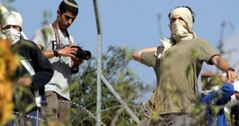
A horde of Jewish settlers on Wednesday attacked Palestinian farmers as they were working their land in the southeast of Nablus.
According to local sources, the settlers assaulted and brutalized several Palestinian farmers as they were cultivating their lands inside the illegal settlement of Eli, which was established on lands annexed from Qaryut village in Nablus.
Local activist Bashar al-Qaryuti said that dozens of farmers went to their lands that are located within the boundaries of Eli settlement after obtaining access permits from the Israeli occupation authority (IOA).
Qaryuti affirmed that Israeli soldiers provided protection for the settlers during their assault on the farmers and detained 25 farmers until police officers arrived and took their statements.
He pointed out that the IOA allows the local farmers to reach their lands inside the settlement twice a year, warning of Israeli intents to annex these agricultural lands to build more housing units for settlers.
According to local sources, the settlers assaulted and brutalized several Palestinian farmers as they were cultivating their lands inside the illegal settlement of Eli, which was established on lands annexed from Qaryut village in Nablus.
Local activist Bashar al-Qaryuti said that dozens of farmers went to their lands that are located within the boundaries of Eli settlement after obtaining access permits from the Israeli occupation authority (IOA).
Qaryuti affirmed that Israeli soldiers provided protection for the settlers during their assault on the farmers and detained 25 farmers until police officers arrived and took their statements.
He pointed out that the IOA allows the local farmers to reach their lands inside the settlement twice a year, warning of Israeli intents to annex these agricultural lands to build more housing units for settlers.
17 apr 2019
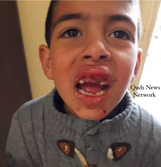
An illegal colonist ran over a Palestinian child in Hebron, in the southern part of the occupied West Bank, Tuesday, and fled the scene, according to Quds News.
The unidentified colonist struck Omar Ra’fat Salaymah, 6 years old, with his car while the child was on his way home from school in the Salaymah neighborhood.
Palestinian medics promptly transported the child to a medical center in Hebron; his wounds have been described as a moderate.
Such attacks are on the rise, and nowhere is this more evident than in Hebron, where Benjamin Netanyahu cancelled the long standing agreement with the Temporary International Presence in Hebron (TIPH), and forced them out.
On February 25, 1994, Baruch Goldstein, an American-Israeli right-wing extremist opened fire in the Ibrahimi Mosque in occupied Hebron, killing 29 Palestinian Muslim worshipers.
On 31 March, 1994, representatives of the Palestinian Liberation Organization and the Israeli government signed an agreement requesting Italy, Denmark and Norway to provide observers to form a Temporary International Presence in the City of Hebron (TIPH).
Article 49 of the 4th Geneva Convention states that the occupying state (Israel) is forbidden to transfer its own population onto the land it occupies (Palestine), therefore under international law, all Israeli settlements are illegal.
The unidentified colonist struck Omar Ra’fat Salaymah, 6 years old, with his car while the child was on his way home from school in the Salaymah neighborhood.
Palestinian medics promptly transported the child to a medical center in Hebron; his wounds have been described as a moderate.
Such attacks are on the rise, and nowhere is this more evident than in Hebron, where Benjamin Netanyahu cancelled the long standing agreement with the Temporary International Presence in Hebron (TIPH), and forced them out.
On February 25, 1994, Baruch Goldstein, an American-Israeli right-wing extremist opened fire in the Ibrahimi Mosque in occupied Hebron, killing 29 Palestinian Muslim worshipers.
On 31 March, 1994, representatives of the Palestinian Liberation Organization and the Israeli government signed an agreement requesting Italy, Denmark and Norway to provide observers to form a Temporary International Presence in the City of Hebron (TIPH).
Article 49 of the 4th Geneva Convention states that the occupying state (Israel) is forbidden to transfer its own population onto the land it occupies (Palestine), therefore under international law, all Israeli settlements are illegal.
16 apr 2019
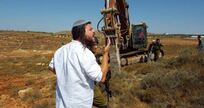
Palestinian farmers on Tuesday said that Israeli settlers have razed vast tracts of their lands near Ariel settlement, north of Salfit, without prior notice.
The farmers told the PIC reporter that they were allowed access to their lands on Tuesday after a three-day ban by the Israeli authorities and they were shocked to see their lands bulldozed by the settlers.
They added that about 30 dunums of land were bulldozed and the razing has not stopped yet.
Local sources said that the Israeli settlers' recent land-razing operations serve as a prelude to a new plan to build 800 housing units in Ariel settlement, which is part of Prime Minister Benjamin Netanyahu's election campaign.
They noted that the settlement expansion activity has been stepped up recently in Ariel. Based on a newly-approved project, Israel has started the construction of several buildings for the Faculty of Medicine at Ariel University, the only university in the West Bank settlements.
The farmers told the PIC reporter that they were allowed access to their lands on Tuesday after a three-day ban by the Israeli authorities and they were shocked to see their lands bulldozed by the settlers.
They added that about 30 dunums of land were bulldozed and the razing has not stopped yet.
Local sources said that the Israeli settlers' recent land-razing operations serve as a prelude to a new plan to build 800 housing units in Ariel settlement, which is part of Prime Minister Benjamin Netanyahu's election campaign.
They noted that the settlement expansion activity has been stepped up recently in Ariel. Based on a newly-approved project, Israel has started the construction of several buildings for the Faculty of Medicine at Ariel University, the only university in the West Bank settlements.
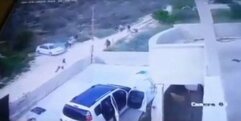
Israeli human rights organization Yesh Din said that a group of masked settlers, from Yitzhar settlement, attacked a family in the neighboring Palestinian village of Urif, south of Nablus, with stones, on Saturday.
Security camera footage from the village shows a Palestinian mother carrying a child into a car, while other family members walk around it. The settlers then come running down the road and start hurling stones at them.
Afterwards, the mother and a family member rush to grab their children, and then flee to the house.
According to Urif residents, some 50 settlers stormed the village’s eastern neighborhood, smashing car windows and throwing stones at houses.
An Israeli army spokesman said that the “friction” between Palestinians and Israelis ended when soldiers and policemen dispersed the crowd. However, they did not arrest any settlers.
The United Nations said, in a February report, that acts of violence and vandalism committed by Israeli settlers, against Palestinians and their property, have risen since the beginning of 2019.
About 600,000 Israelis live in over 230 illegal settlements built since the 1967 occupation of the Palestinian territories of the West Bank and East Jerusalem, according to the PNN.
Palestinians want the West Bank as part of a future independent Palestinian state, with East Jerusalem al-Quds as its capital. Israel’s continued settlement expansion, on Palestinian territories, has been a major sticking point in Israeli-Palestinian talks, which have stalled since 2014.
Security camera footage from the village shows a Palestinian mother carrying a child into a car, while other family members walk around it. The settlers then come running down the road and start hurling stones at them.
Afterwards, the mother and a family member rush to grab their children, and then flee to the house.
According to Urif residents, some 50 settlers stormed the village’s eastern neighborhood, smashing car windows and throwing stones at houses.
An Israeli army spokesman said that the “friction” between Palestinians and Israelis ended when soldiers and policemen dispersed the crowd. However, they did not arrest any settlers.
The United Nations said, in a February report, that acts of violence and vandalism committed by Israeli settlers, against Palestinians and their property, have risen since the beginning of 2019.
About 600,000 Israelis live in over 230 illegal settlements built since the 1967 occupation of the Palestinian territories of the West Bank and East Jerusalem, according to the PNN.
Palestinians want the West Bank as part of a future independent Palestinian state, with East Jerusalem al-Quds as its capital. Israel’s continued settlement expansion, on Palestinian territories, has been a major sticking point in Israeli-Palestinian talks, which have stalled since 2014.
